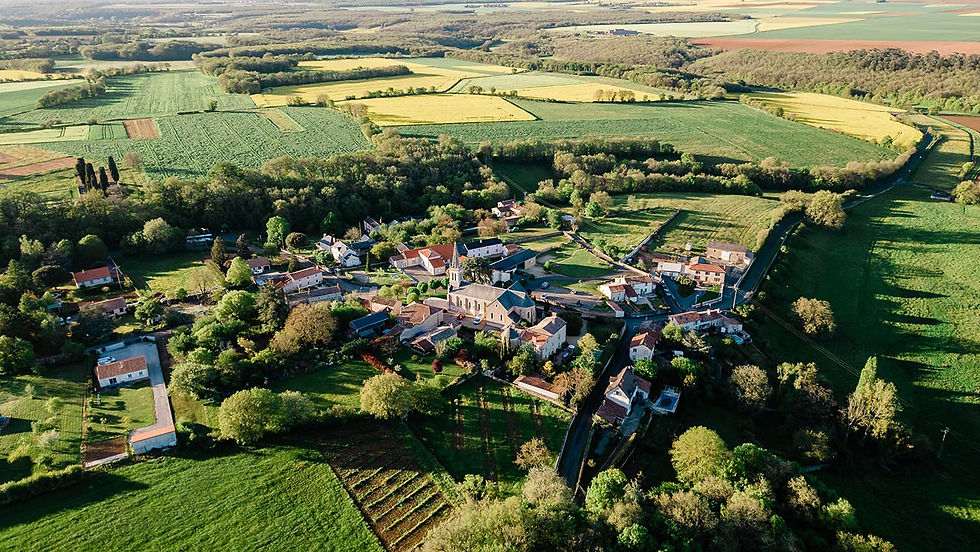Things to do - A Visit to Historical Poitiers
- Paula Dormer
- Oct 5, 2023
- 3 min read
Getting to Poitiers from Pressigny.
Poitiers has a plethora of places to visit, things to do and festivals to enjoy. Just under an hour from Pressigny, the journey to our local Big City involves crossing the edge of the an enormous plain, known as the bread basket of France. Emerging from the Pressigny valley, full of green trees and verdant pastures, the contrast at the crossroads on the edge of the village is almost shocking. From bucolic, almost English countryside to sweeping plain, wide open skies and flat fields, a traveller could almost be in Italy. Travelling through vinyards on the crest of the hill above Thenezay, the journey to Poitiers passes quickly, cars few and far between; oilseed rape, wheat, barley and suflowers growing below, depending on the season.
Historic Poitiers
Boasting a UNESCO world heritage site, Saint-Hilare Church and the Roman Saint-John Baptistry, in almost constant use for over 1500 years, it's hard to know where to start. Fortunately the Poitiers Tourist Office has a wealth of literature to help you decide. Pilgrims have, for centuries followed the marked patheways of the route to Santiago de Compostella through Poitiers, carrying their tell tale scallop shells, the mark of the pilgrim, with them. For history lovers, the old Palace of the Counts of Poitou and Dukes of Aquitaine, built between 1194 and 1204 is a must to visit. Built by Eleanor of Aquitaine, it is one of the most remarkable pieces of Plantagenet architecture in France. The great hall, with its three massive fireplaces occuplying the entire width of one wall and the enormous hall, 47m long and 17m wide, held her entire court. It is a remarkable example, along with the Maubergeon hall, of the architecture of the period and should not be missed.
Saint-Hilaire-Le-Grand Church has been a stage on the route to Santiago de Compostella trail since the 12th century. Not quite so jolly are the four chapels adorned with Romanesque frescos representing a scene from the Apocolypse, but this is counteracted by an astonishingly high trascept and choir that are full of light. Built in the 11th century it is yet another of Poitier's incredible historic buildings open to the public.
Descending into the Saint-John Baptistry it truly feels as if you are travelling back in time as the steps take you down below street level. Built mostly in the 4th century, the original font was constructed in a Gallo-Roman house in Poitiers, the converts being fully immersed in the water. Reputedly built over a pagan site, the octagonal font is in the heart of the building. On the walls high above the font are vivid frescos, amazingly well preserved and there is a collection of Roman artifacts around the walls. In almost constant use for 1500 years, it is a must for people interested in Gallo-Roman arcitecture and Roman history.
Heritage Discovery Circuits
In order to give visitors the best chance of seeing the wealth of historical architecture in Poitiers, The Grand Poitiers Tourist Office offers Heritage Discovery Circuits with audio-guides. Urban planners, historians and archtects fill the visit with detailed facts and information and are available from the Tourist office or can be downloaded via the 'Poiters ZeeVisit app on a smartphone for free. Four versions are available -
The Episcopal District, which follows the ancient Grand'Rue, with its timber framed houses, narrow stone facades and beautiful town houses, as well as Saint-Pierre Cathederal and the Saint-Jean Baptisty.
The Saint-Hilaire District. From the pedestrian only area in town, the route follows a trail to Saint-Hilare, named after the first known Bishop of Poitiers. En route you will discover various sites associate with Saint Hilary. You finish at the UNESCO world heritage site of Saint-Hilaire-le-Grand Church.
The Montierneuf District - Stroll gently along the winding route of the Rue de La Chaine, glimpsing into interior courtyards and gardens of the churches, squares and townhouses until you reach Saint-Jean-de-Montierneuf church and its pretty surrounding district.
The Modern Town - This route reveals the most symbolic buildings from the 19th century onwards. Interpreted by architects and urban planners, you are led to understand how the past has influenced the design of a square, or a building by politics, or sociology in places along the route.
There is also an app to download free, 3D Poitiers Evolution, in which you can visit Poitiers over time. It offers a panaramic view of Poitiers from antiquity to the modern day.
.png)



Comments